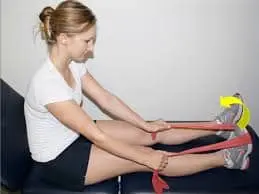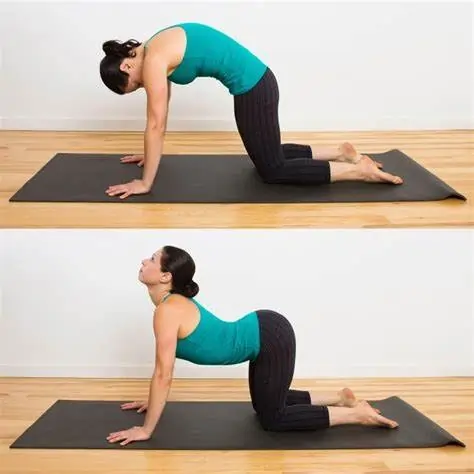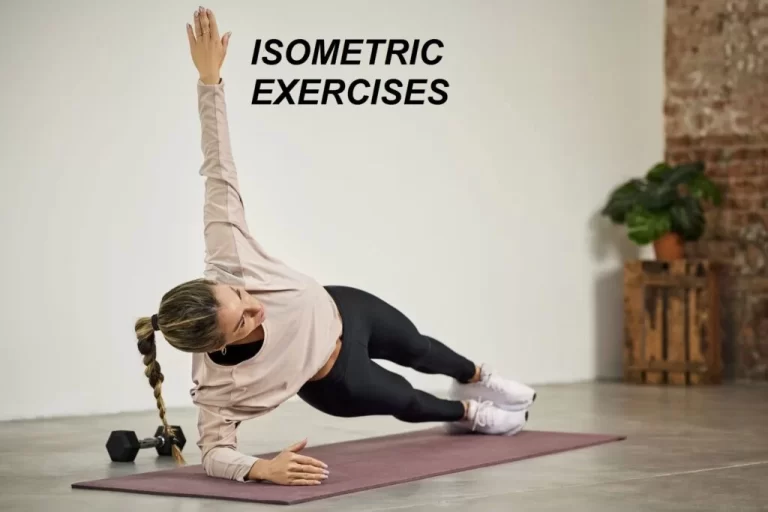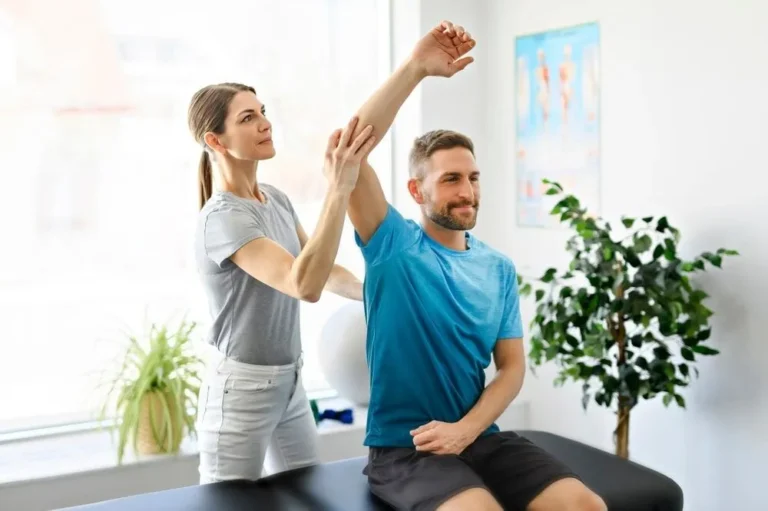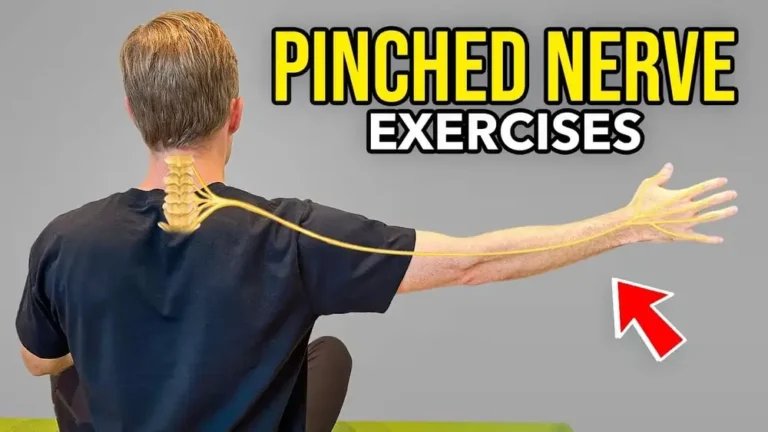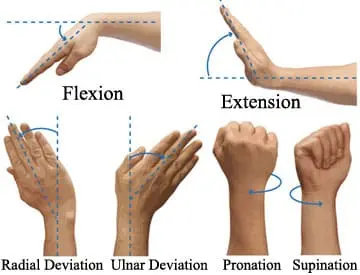16 Best Exercise for Planter Fascitis
When exercising to treat plantar fascitis, your focus should be on strengthening and stretching activities that improve foot function. Improving plantar fascia ligament flexibility might help in reducing inflammation and pain associated with heel pain, as well as preventing additional strain.
Introduction:
The condition known as plantar fasciitis affects the foot’s plantar fascia, primarily in the area surrounding the arch or heel. It is associated with heel pain. The ligament connecting your heel to your toes, the plantar fascia, may be overstressed, which could cause stress on the heel. Moreover, overstretching yourself during any kind of activity can result in little tears and pain.
Poor management of plantar fasciitis can lead to heel spur pain, which is the growing of the heel bone, as well as heel pain. Most persons with plantar fasciitis start to feel difficulty when they get up from bed in the early morning or when they get up after spending a lot of time sitting down. Walking or taking a few steps usually relieves the aches and stiffness.
Both the flexibility and function of the foot are improved by exercises that lengthen and strengthen the muscles surrounding the heel. Plantar Fascitis exercises, the use of ice and hot packs, avoiding unpleasant activities, resting your heel enough for healing, and using suitable shoe inserts all contribute to the relief of pain and other symptoms.
Exercise for Planter Fascitis is important for strengthening the muscles, tendons, and ligaments that surround the heel and improving overall foot health.
Causes:
- Having to stand all day at work.
- Engaging in sports.
- Flat feet
- Exercising without first warming up or stretching.
- Put on footwear that doesn’t offer enough support for your feet, such as flip-flops or flat, floppy sneakers.
Signs and symptoms:
- Ankle pain or, in rare cases, pain at the base of the midfoot are the main complaints of people with plantar fasciitis. It normally only affects one foot, although it may affect both.
- Plantar fasciitis causes pain that gradually worsens over time. It might hurt dully or harshly. A burning or aching sensation that radiates from the heel is experienced by certain individuals.
- After spending a long period sitting or lying down, or when you first get out of bed in the morning, the pain is typically stronger.
- Stairs to climb can be difficult if your heels are stiff.
- A sudden increase in pain during prolonged activity may be caused by increased irritation or inflammation. Pain from plantar fasciitis usually manifests after exercise, not during.
Risk factor:
- Standing for extended lengths of time.
- Are obese or overweight, This is because your plantar fascia ligaments are under more strain, particularly if you’ve recently gained a lot of weight.
- Calf muscles are tight
- Having a high arch or flat feet
- Run for extended periods.
- Employment as a waiter at a restaurant or in an at work, frequently moving workplace, like a factory.
Exercise advantages:
- Become more balanced and with better posture.
- Exercise can help you extend your flexibility.
- Try minimizing your pain as much as you can.
- Facilitating the relaxation of muscles.
- Therefore, be more flexible.
- This strengthens the weaker muscles.
Before starting an exercise regimen, take into account the following safety precautions:
Consider a few safety precautions and maximize the benefits before beginning any exercise program. Find out which exercises are best for your problem by speaking with your physician or physical therapist. It is crucial to understand your body’s requirements and refrain from pushing yourself when it hurts. Even while pain is a typical adverse effect of physical activity, excessive or persistent pain may indicate tiredness. Start with low-impact exercises and work your way up to more difficult ones when you can tolerate a greater level of pain.
Repetitive injury prevention requires maintaining good form and posture. See a doctor if you’re not sure how to start exercising properly. To get your joints and muscles ready for the action, warming up your body before starting any exercise program.
Exercise for Planter Fascitis:
The best workouts for plantar fasciitis and heel pain can vary from person to person and involve different foot and calf stretches. In addition to strengthening muscles and improving foot flexibility, they may help in alleviating pain.
Ankle-toe movement
- The first thing to do is lie down on the bed straight.
- After that, make an effort to get your toes as near to your body as you can.
- Hold this position for a few seconds.
- Put them away after that.
- Then return to your neutral position.
- Then relax.
- Repeat this exercise five to ten times.
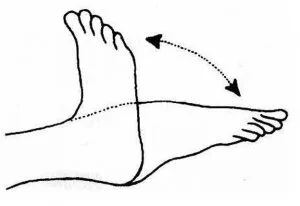
Ankle circle
- To start, find a relaxing spot on the ground.
- Both clockwise and counterclockwise rotations of your ankle should be done carefully ten times.
- Take cautious not to twist your full leg as you move your foot and ankle.
- To add variation, try using your big toe to circle the letters.
- Then return to your neutral position.
- Then relax.
- Repeat this exercise five to ten times.
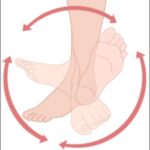
Tennis Ball Roll
- When sitting in the chair, maintain an upright position and place your toes flat on the ground.
- Ideally, you want to put a tennis ball down near your feet.
- The ball can be moved in various directions by applying as much pressure as comfortable with one foot.
- Applying pressure to the foot is the ball’s activity.
- Continue the ball moving for an additional two to three minutes.
- Then return to your neutral position.
- Then relax.
- Repeat this exercise five to ten times.
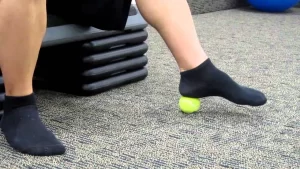
Toe Curls with a Towel
- Sit (or stand if you like) with your heels below your knees.
- Make sure the toes on both your legs and feet are pointed forward and parallel to each other.
- Place a level foot on the towel after spreading it out.
- As you flex your foot back and lift your toes, maintain your heel down.
- Step out as far as you can on the towel by equally extending your foot along the middle and both sides while keeping your heel on the cloth.
- As you squeeze the towel in, make sure your heel stays in place by using your toes and arch.
- Direct the towel toward you.
- Using all five fingertips on both sides of the foot, pull a broad circle directly beneath the arch.
- With every extension and limitation, you will only be able to move a certain portion of the towel.
- Then return to your neutral position.
- Then relax.
- Repeat this exercise five to ten times.

Marble Pickup
- Put both of your feet flat on the ground while seated in an upright chair.
- The ground in front of the feet should have two bowls: one empty and one containing twenty or more marbles.
- Put each marble into the empty bowl using just one foot’s toes.
- Then return to your neutral position.
- Then relax.
- Repeat this exercise five to ten times.
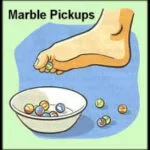
Calf Stretching exercise
- Now you should face a wall or other solid object and take your place.
- Point both of your toes straight forward while taking one forward stride.
- Leg backward and knee extension are common ways to stretch.
- Maintain your arms holding your body by extending your front knee as you move forward toward the wall.
- This ought to allow your leg to stretch a little bit down the back.
- Reposition yourself such that your back leg can extend by stepping in or out of the wall.
- To improve control over the stretch, the bend of the front knee can also be adjusted.
- Hold this position for a few seconds.
- Then return to your neutral position.
- Then relax.
- Repeat this exercise five to ten times.
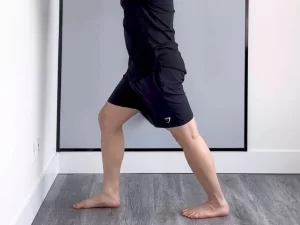
Calf stretch off step
- Choose a step (the top of the staircase works well), and use one hand to hold onto the railings to ensure that it is secure and you won’t fall.
- Maintain a straight posture with your knees while standing on the edge of the step, allowing your heels to drop.
- Raise one leg until your entire weight is passing through that calf.
- The muscles in your calves should feel stretched and tightened.
- Hold this position for a few seconds.
- Then return to your neutral position.
- Then relax.
- Repeat this exercise five to ten times.
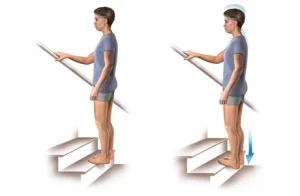
Seated Plantar Fascia Stretch
- Assume a sitting position and place your ankle on top of your other leg by crossing one leg over the other knee.
- Pull your toes back gently till the bottom of your foot starts to expand while one hand is holding your ankle and the other is holding your toes.
- Hold this position for a few seconds.
- Then return to your neutral position.
- Then relax.
- Repeat this exercise five to ten times.
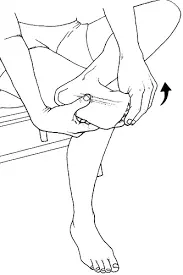
Towel stretch
- You may perform this easy stretch while seated on the floor or in bed.
- Seated on the floor or in your bed, extend your legs in front of you.
- Place the towel beneath your heels after you’ve wrapped its ends.
- Pull the cloth slowly in the direction of yourself while keeping your knee straight.
- Hold this position for a few seconds.
- Then return to your neutral position.
- Then relax.
- Repeat this exercise five to ten times.
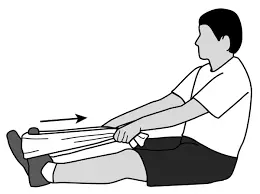
Toe Extension
- Ensure that your back is straight as you sit and set your feet flat on the floor.
- Lift one foot and place it on the other thigh.
- Stretch your Achilles tendon and the bottom of your foot by grasping the tips of your feet with one hand and pulling them into your ankle.
- When you stretch, contact your foot’s arch with your other hand.
- Hold this position for a few seconds.
- Then return to your neutral position.
- Then relax.
- Repeat this exercise five to ten times.
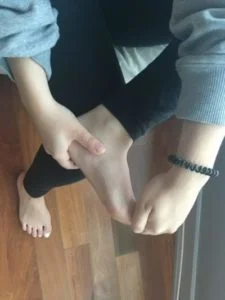
Single leg standing
- Hold a solid chair or table for stability.
- Maintain close to the chair or table while facing away from it.
- Take a comfortable knee bend and lift one foot off the floor.
- The non-standing leg can be kept straight, slightly elevated, or bent, depending on the patient’s comfort level and skills.
- Maintaining balance while engaging your core muscles should be your main goal.
- Refrain from depending on or tilted toward one side.
- Stretch out that initial short period of balance gradually as your strength increases.
- Use the chair or countertop as support if needed, but try relying less on it as you become more secure.
- Then return to your neutral position.
- Then relax.
- Repeat this exercise five to ten times.
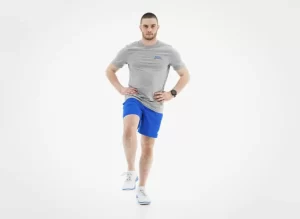
Heel raise
- Take a couple of deep breaths and select a spot where you can stand comfortably.
- Grab a chair if you require support.
- Elevate your heels and shift most of your weight to the outside of your feet.
- Hold this position for a few seconds.
- Bring your heels down.
- Then return to your neutral position.
- Then relax.
- Repeat this exercise five to ten times.
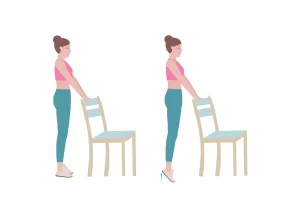
Tip Toe Walking
- Tiptoes walking is a technique in which you should walk on tiptoes.
- You may strengthen the muscles and ligaments in your feet, ankles, and legs with this great method.
- It also improves stability.
- It is easy to complete five to ten rounds of toe walking in one sitting.
- The balance muscles in the ankle joint are strengthened when one walks on tiptoe.
- This provides balance and stability to the ankle joint.
- Then return to your neutral position.
- Then relax.
- Repeat this exercise five to ten times.

Ice bottle massage exercise
- Place one foot on a little ball or frozen water bottle as you stand or sit.
- An ice-filled bottle of chilled water is helpful since it relieves inflammation.
- With a gently backward and forward movement, move the ball or water bottle beneath your foot.
- Start just below the ball of your foot and finish just in front of your heel.
- For every ten repetitions, gently roll the bottle or ball back and forth.
- Then return to your neutral position.
- Then relax.
- Repeat this exercise five to ten times.
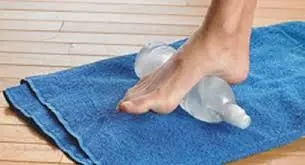
Seated foot stretch
- Place your affected heel over your other leg while you sit in a chair.
- Draw the toes in toward the shin to tenser the arch of the foot.
- Feel for any pain in the plantar fascia on the foot’s bottom with the opposite hand.
- Hold this position for a few seconds.
- Then return to your neutral position.
- Then relax.
- Repeat this exercise five to ten times.
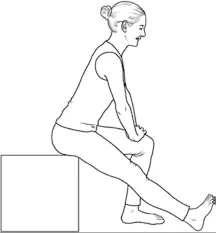
Sand walking
- Keep an eye out for any sandy location you come across, such as a volleyball court, a beach, or a desert.
- Take your socks and shoes off.
- Go walks as often as possible.
- Try to increase the distance gradually to avoid overstressing your calves and feet muscles.
- Then relax.
- Walks with a minimum duration of ten to twenty minutes.
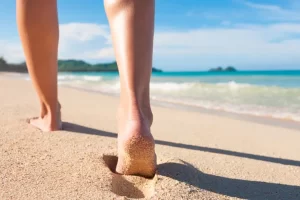
What precautions need to be followed for safety when working out?
- Refrain from taking on difficult exercises.
- Stopping exercise as soon as the pain becomes severe is advised.
- Straighten your posture when working out.
- To avoid falling while exercising, look for yourself and stay focused.
- When working out, try to avoid utilizing any force or quick motions.
- Stretching according to the protocol should be done before and after sets, as well as for the prescribed number of repetitions for each exercise.
- Wear loose, comfortable attire during your workout to increase your range of motion and promote relaxation. Stay away from anything overly fashionable or tight.
- It’s important to bend and stretch softly.
- Take a break in between each workout.
- It’s normal to stretch the muscles in your tight joints, although it might be challenging at times. Because they are unhealthy and aggravate your disease, stretching and exercise shouldn’t hurt or make you feel like someone is stabbing you.
- Remain hydrated.
What time will you stop exercising?
- Fever
- If exercising hurts, you should stop.
- Intense muscle burning.
- You’re not feeling well.
- If there is pain or numbness.
- blurry vision
- Headache
Prevention:
A few small lifestyle adjustments could help you stay away from plantar fasciitis.
- Before and after a workout session, stretch.
- Wear supportive shoes with good arch support, and replace your athletic footwear often. For runners, the recommended distance between each pair of shoes and the time you should replace them is 400–500 kilometers.
- Make every effort to maintain a healthy weight. If you are overweight, one way to lessen the tension on your plantar fascia is to lose weight.
- Include low-impact workouts like cycling or swimming in your regimen. Before beginning any workout, make sure to stretch your Achilles tendon, plantar fascia, and calves.
Summary:
In the heel to the toes, there is a thick band of tissue called the plantar fascia. This tissue may become inflamed due to overuse, strain, or injury, which may be uncomfortable.
Heel pain might be attributed to a condition called plantar fasciitis. Although it can afflict persons of all ages and skill levels, runners and those who spend a lot of time on their feet are more likely to experience it.
Plantar fasciitis can cause an intense, stabbing pain in the heel. Although runners may experience it as an overuse ailment, it frequently happens to individuals who are overweight. The pain is usually severe in the mornings or after standing for extended periods of time.
Surgery is not always necessary to cure plantar fasciitis in people. Instead, medical procedures, at-home treatments, and physical therapy help in improving the health of patients.
FAQ:
Is it possible to treat plantar fasciitis by stretching?
By releasing tension and encouraging plantar fascia healing, stretching on its own can effectively reduce and sometimes even cure plantar fasciitis.
Which workout is best for treating plantar fasciitis?
Tennis ball roll.
Towel stretch.
Toe stretch.
Toe curls.
Calf stretch.
Does walking help with plantar fasciitis?
Plantar fasciitis symptoms may be relieved by walking after lying down or sitting for a while, as the ligament expands. But as the day goes on, the pain will progressively get worse, making you quite uncomfortable and interfering with your regular tasks.
How did my plantar fasciitis eventually go away?
With conservative treatment, which includes cooling the painful area, stretching, and adjusting or avoiding unpleasant activities, the majority of patients with plantar fasciitis heal in a few months.
When dealing with plantar fasciitis, what should you avoid doing?
High-impact exercises, prolonged standing, and wearing shoes that are not supportive should all be avoided when managing plantar fasciitis. Don’t eat anything that makes your inflammation worse. Primarily, heed your doctor’s advice and don’t disregard the pain. With the correct care and relaxation, you may speed up your rehabilitation.
Is plantar fascia massage safe to perform?
There are very few risks associated with plantar fasciitis massage when done properly. However, if someone rubs the sole vigorously when the fascia is inflamed, it could cause sensitivity. This can make the pain worse. It’s imperative to move carefully forward and to stop if the discomfort becomes intolerable.
Does plantar fasciitis create a significant risk?
For heel pain, plantar fasciitis is the main underlying reason. If the discomfort in your foot or heel doesn’t go away after a week, see a doctor. They can help you in locating at-home remedies to lessen your foot’s pain and swelling.
Will plantar fasciitis resolve by itself?
Although plantar fasciitis is a self-healing condition, the pain may not go away for over a year. If left untreated, complications may arise. Starting non-surgical therapy as soon as possible is recommended after seeing your doctor.
References:
- August 14, 2022, Dhameliya, N. Treat Planter Fascitis with exercise. exercises for plantar fasciitis at https://samarpanphysioclinic.com. Plantar fasciitis exercises are available at https://samarpanphysioclinic.com.
- June 25, Villines, Z. (2024c). The best plantar fasciitis exercises and stretches. As per the following article, “Health News Today (USA): 324535,”
- Sept. 9, 2024: Plantar Fasciitis. https://my.clevelandclinic.org/health/diseases/14709-plantar-fasciitis Cleveland Clinic
- Confirmed by physicians at Star Health. 2024, August 5. Activities for Plantar Fasciitis: Ten Stretches to Alleviate Pain. Star Health. Exercises for Plantar Fasciitis: https://www.starhealth.in/blog
- February 10, 2023: Colbert, T. Heel Pain Relief with Plantar Fasciitis Stretches. Stretches for plantar fasciitis: https://www.healthline.com/health/fitness-exercise
- Image 8, September 18, 2019: Liu, C. The first step in Markham Physical therapy & Rehab is to stretch your plantar fasciitis. Markham Physiotherapy & Rehabilitation came first. Plantar fasciitis stretches can be found at https://www.firstmarkhamrehab.com/blog.
- Image 14, On July 30, 2018, Amacht. Macht Medical Group | Plantar Fasciitis. Macht Healthcare Organization. /tag/plantar-fasciitis/ on http://www.machtmedicalgroup.com

